Do you know what is self cleaning water heater? If not yet, then don’t worry. You come to the right place because we are here to help you out. Self-cleaning water heaters are those heaters that automatically remove all the sediments that are present at the bottom of the heater.
Water circulation is used to take away deposition in self-cleaning water heaters, minimizing the need to cleanse the system. It won’t eliminate sediment accumulation, but it will get rid of the vast bulk of it. Self-cleaning models are available in both electric and gas versions.
The sediment at the tank’s base in water heaters must be drained regularly. Even when the deposit is depleted, it accumulates and leaves less area in the tanks for water. When sediment covers the heat source of an electric water heater, it loses efficiency over time. Below we have discussed in detail what are self-cleaning water heaters, how do they work, and their advantages. Let’s get started.
Self-Cleaning Water Heater
Are you wondering about what is self cleaning water heater? Well, wonder no more in this paragraph; you will get the answer. Water heaters that clean themselves on their own are called self-cleaning water heaters. Both the gas-powered and electric water heaters can be available as self-cleaning water heaters. The self-cleaning system is designed to stop the water and sediment from circulating to avoid accumulation on the base or the electric element.
Even though the water heater becomes outdated, this self-cleaning vortex protects the part, eliminates leakage, and delivers you a complete tank of hot water. Remember, those self-cleaning water heaters are better than non-self-cleaning water heaters, but they’re not ideal.
How Does Self Cleaning Water Heater?
Water includes contaminants that may evade your water heater’s in-tank filtering system. The capacity of the heater to increase the temperature adequately is harmed by sediment growth. The sediment coatings conceal the heating element at the base of a heater. An insulating layer is created between the water and heating source. Consequently, the heaters take much lengthier to heat water, and even though they can, the temperature of the water isn’t appropriate. Water enters a self-cleaning water heater and is carried to the tank’s base primarily by dipping pipe, as is customary. The attachment at the tip of the dip pipe, though, spins the water as it flows in and heats it when it hits bottom. Ultimately, when you employ the hot water, the sediment along with hot water drains via the heated water exit.
The Sediment Problem
Pollutants in your water, typically calcium carbonate, cause sediment to build. Having the deposition agitated and away from the heating element, and the tank’s bottom prevents corrosion to the element and scale accumulation. Although with the most excellent self-cleaning radiators, sediment granules often seem to settle to the bottom since they are heavier than water. Sediment buildup leads the container to be hot at the bottom, causing the water heater to leak. Even though the self-cleaning water heater does not remove all of the silt from the tank’s base, it does help to limit accumulation and prolong the heating element and tank life. Here are the ways how to get sediment out of water heater and to prevent sediment buildup.
Disadvantages Of Self Cleaning Water Heater
Although a self-cleaning water heater is much more expensive at first, you could be able to offset your investment over time due to the unit’s increased longevity and effectiveness. The sediment that a self-cleaning water heater removes does not get into your water heating; nevertheless, it does remove the residue. You may avoid ingesting the sediment by sipping from a cold-water faucet. Your self-cleaning hot water tank will ultimately accumulate silt decrease effectiveness and storage capabilities.
If your water heater has a drainage hole on the base, emptying some water from the bottom will extend the longevity of every hot water system, even just a self-cleaning model. A self-cleaning water heater doesn’t need to be cleaned as frequently as a traditional water heater, but it must be cleaned only once in three years or so. It’s the same as flushing a regular model. If your healthy water is heavy in minerals, you may have to wash it more frequently. Immediately turn off the heater and let the components settle for a few hours before draining and flushing to limit the danger of fires.
Lifespan Of Self Cleaning Water Heater
A self-cleaning water heater has an average life expectancy of 8 to 12 years. The average life expectancy of a non-self-cleaning water heater is 6 to 12 years. Whereas the lifespan variation is modest, the self-cleaning device provides enormous ease. It makes a huge impact, mainly if you wouldn’t regularly clean your hot water system. With regular care, the self-cleaning device might last up to 15 years. Know when to replace water heater.
It’s A Wrap!
We hope that reading this article is just fun for you, and after reading it, you all will get a better understanding of what is self cleaning water heater. Remember that a self-cleaning water heater automatically cleans the sediments on the bottom and increases its function efficiency compared to the non-self-cleaning water heater. Thank you, friends, for being with us at the end!

